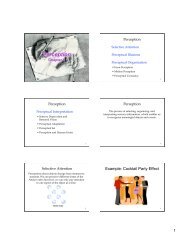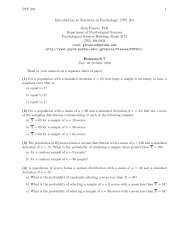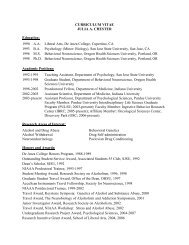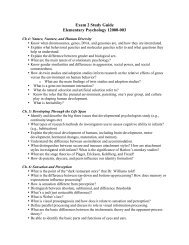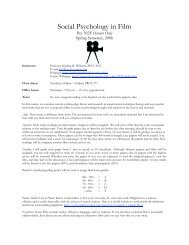Introduction to Statistics in Psychology: PSY 201 - Department of ...
Introduction to Statistics in Psychology: PSY 201 - Department of ...
Introduction to Statistics in Psychology: PSY 201 - Department of ...
Create successful ePaper yourself
Turn your PDF publications into a flip-book with our unique Google optimized e-Paper software.
<strong>PSY</strong> <strong>201</strong> 1<br />
<strong>Introduction</strong> <strong>to</strong> <strong>Statistics</strong> <strong>in</strong> <strong>Psychology</strong>: <strong>PSY</strong> <strong>201</strong><br />
Greg Francis, PhD<br />
<strong>Department</strong> <strong>of</strong> Psychological Sciences<br />
Psychological Sciences Build<strong>in</strong>g, Room 3174<br />
(765) 494-6934<br />
email: gfrancis@purdue.edu<br />
http://www1.psych.purdue.edu/∼gfrancis/Classes/<strong>PSY</strong><strong>201</strong>/<br />
Homework 8<br />
Due: 18 Oc<strong>to</strong>ber 2009<br />
Hand <strong>in</strong> your answers on a separate sheet <strong>of</strong> paper.<br />
(1) A researcher develops a new theory that predicts that vegetarians will have more <strong>of</strong> a particular<br />
vitam<strong>in</strong> <strong>in</strong> their blood than non-vegetarians. An experiment is conducted and vegetarians do have<br />
more <strong>of</strong> the vitam<strong>in</strong>, but the difference is not significant. The probability value is 0.13. Should the<br />
experimenter’s confidence <strong>in</strong> the theory <strong>in</strong>crease, decrease, or stay the same Expla<strong>in</strong> your choice.<br />
(2) A significance test is performed and p = .20. Why can’t the experimenter claim that the<br />
probability that the null hypothesis is true is .20<br />
(3) You choose an alpha level <strong>of</strong> .01 and then analyze your data.<br />
a) What is the probability that you will make a Type I error given that the null hypothesis is<br />
true<br />
b) What is the probability that you will make a Type I error given that the null hypothesis is<br />
false<br />
(4) Although there is a popular belief that herbal remedies such as G<strong>in</strong>kgo biloba and G<strong>in</strong>seng<br />
may improve learn<strong>in</strong>g and memory <strong>in</strong> healthy adults, these effects are usually not supported by<br />
well-controlled research (Peresson et al., 2004). In a typical study, a researcher obta<strong>in</strong>s a sample<br />
<strong>of</strong> n = 36 participants and has each person take the herbal supplements every day for 90 days. At<br />
the end <strong>of</strong> the 90 days, each person takes a standardized memory test. For the general population,<br />
scores from the test are normally distributed with a mean <strong>of</strong> µ = 80 and a standard deviation <strong>of</strong><br />
σ = 18. The sample <strong>of</strong> research participants had an average <strong>of</strong> X = 84.<br />
a) In a sentence, state the null hypothesis be<strong>in</strong>g tested.<br />
b) Us<strong>in</strong>g symbols, state the null hypothesis and the alternative hypothesis.<br />
c) Conduct the hypothesis us<strong>in</strong>g a two-tailed test with α = 0.05.
<strong>PSY</strong> <strong>201</strong> 2<br />
(5) A researcher is test<strong>in</strong>g the effectiveness <strong>of</strong> a new drug that is <strong>in</strong>tended <strong>to</strong> improve learn<strong>in</strong>g and<br />
memory performance. A sample <strong>of</strong> n = 16 rats is obta<strong>in</strong>ed, and the rats are adm<strong>in</strong>istered the drug<br />
and then tested on a standardized learn<strong>in</strong>g task. For the general population <strong>of</strong> rats (with no drugs)<br />
the average score on the standardized task is µ = 50 with a standard deviation <strong>of</strong> σ = 10. The<br />
distribution <strong>of</strong> test scores is normal.<br />
a) If the drug has a 4-po<strong>in</strong>t effect and produces a mean score <strong>of</strong> X = 54 for the sample, is this<br />
sufficient <strong>to</strong> conclude that there is a significant effect us<strong>in</strong>g a two-tailed test with α = 0.05<br />
b) If there is a 6-po<strong>in</strong>t effect with a mean score <strong>of</strong> X = 56, is this sufficient <strong>to</strong> conclude that<br />
there is a significant effect us<strong>in</strong>g a two-tailed test with α = 0.05<br />
(6) State College is evaluat<strong>in</strong>g a new English composition course for freshmen. A random sample<br />
<strong>of</strong> n = 25 freshmen is obta<strong>in</strong>ed and the students are placed <strong>in</strong> the course dur<strong>in</strong>g their first semester.<br />
One year later, a writ<strong>in</strong>g sample is obta<strong>in</strong>ed for each student and the writ<strong>in</strong>g samples are graded<br />
us<strong>in</strong>g a standardized evaluation technique. The average score for the sample if X = 76. For the<br />
general population <strong>of</strong> college students, writ<strong>in</strong>g score form a normal distribution with a mean <strong>of</strong><br />
µ = 70.<br />
a) If the writ<strong>in</strong>g scores for the population have a standard deviation <strong>of</strong> σ = 20, does the sample<br />
provide enough evidence <strong>to</strong> conclude that the new composition course has a significant effect<br />
Assume a two-tailed test with α = 0.05.<br />
b) If the population standard deviation is σ = 10, is the sample sufficient <strong>to</strong> demonstrate a<br />
significant effect Aga<strong>in</strong>, assume a two-tailed test with α = 0.05.<br />
c) Briefly expla<strong>in</strong> why you reached different conclusions for part (a) and part (b).<br />
(7) A psychologist is <strong>in</strong>vestigat<strong>in</strong>g the hypothesis that children who grow up as the only child <strong>in</strong> the<br />
household develop different personality characteristics than those who grow up <strong>in</strong> larger families. A<br />
sample <strong>of</strong> n = 30 only children is obta<strong>in</strong>ed and each child is given a standardized personality test.<br />
For the general population, scores on the test from a normal distribution with a mean <strong>of</strong> µ = 50<br />
and a standard deviation <strong>of</strong> σ = 15. If the mean for the mean for the sample is X = 58, can the<br />
researcher conclude that there is a significant difference <strong>in</strong> personality between only children and<br />
the rest <strong>of</strong> the population Use a two-tailed test with α = 0.05.<br />
(8) A researcher is test<strong>in</strong>g the hypothesis that consum<strong>in</strong>g a sports dr<strong>in</strong>k dur<strong>in</strong>g exercise will improve<br />
endurance. A sample <strong>of</strong> n = 50 male college students is obta<strong>in</strong>ed and each student is given a series<br />
<strong>of</strong> three endurance tasks and asked <strong>to</strong> consume 4 ounces <strong>of</strong> the dr<strong>in</strong>k dur<strong>in</strong>g each break between<br />
tasks. The overall endurance score for this sample is X = 53. For the general population, without<br />
any sports dr<strong>in</strong>k, the scores for this task average µ = 50 with a standard deviation <strong>of</strong> σ = 12.<br />
a) Can the researcher conclude that endurance scores with the sports dr<strong>in</strong>k are significantly<br />
higher than scores without the dr<strong>in</strong>k Use a one-tailed test with α = 0.05.<br />
b) Can the researcher conclude that endurance scores with the sports dr<strong>in</strong>k are significantly<br />
higher than scores without the dr<strong>in</strong>k Use a two-tailed test with α = 0.05.<br />
c) You should f<strong>in</strong>d that the two tests lead <strong>to</strong> different conclusions. Expla<strong>in</strong> why.
<strong>PSY</strong> <strong>201</strong> 3<br />
(9) Montarello and Mart<strong>in</strong>s (2005) found that fifth-grade students completed more mathematics<br />
problems correctly when simple problems were mixed <strong>in</strong> with their regular math assignments. To<br />
further explore this phenomenon, suppose that a researcher selects a standardized mathematics<br />
achievement test that produces a normal distribution <strong>of</strong> scores with a mean <strong>of</strong> µ = 100 and a<br />
stanard deviation <strong>of</strong> σ = 18. The researcher modifies the test by <strong>in</strong>sert<strong>in</strong>g a set <strong>of</strong> very easy<br />
problems among the standardized questions, and gives the modified test <strong>to</strong> a sample <strong>of</strong> n = 36<br />
students. If the average test score for the sample is X = 104, is this result sufficient <strong>to</strong> conclude<br />
that <strong>in</strong>sert<strong>in</strong>g the easy questions improves performance Use a one-tailed test with α = 0.01<br />
(10) Compute the t values that form the boundaries <strong>of</strong> the critical region for a two-tailed test with<br />
α = 0.05 for each <strong>of</strong> the follow<strong>in</strong>g df values.<br />
a) df = 8<br />
b) df = 15<br />
c) df = 24<br />
(11) A sample is randomly selected from a population with a mean <strong>of</strong> µ = 50, and a treatment<br />
is adm<strong>in</strong>istered <strong>to</strong> the <strong>in</strong>dividuals <strong>in</strong> the sample. After treatment, the sample is found <strong>to</strong> have a<br />
mean <strong>of</strong> X = 56 with a standard deviation <strong>of</strong> s = 8.<br />
a) If there are n = 4 <strong>in</strong>dividuals <strong>in</strong> the sample, are the data sufficient <strong>to</strong> reject H 0 and conclude<br />
that the treatment has a significant effect us<strong>in</strong>g a two-tailed test with α = 0.05<br />
b) If there are n = 16 <strong>in</strong>dividuals <strong>in</strong> the sample, are the data sufficient <strong>to</strong> reject H 0 and conclude<br />
that the treatment has a significant effect Aga<strong>in</strong>, assume a two-tailed test with α = 0.05.<br />
(12) Last fall, a sample <strong>of</strong> n = 36 freshmen was selected <strong>to</strong> participate <strong>in</strong> a new 4-hour tra<strong>in</strong><strong>in</strong>g<br />
program designed <strong>to</strong> improve study skills. To evaluate the effectiveness <strong>of</strong> the new program, the<br />
sample was compared with the rest <strong>of</strong> the freshman class. All freshmen must take the same English<br />
Language Skills course, and the mean score on the f<strong>in</strong>al exam for the entire freshman class <strong>of</strong><br />
µ = 75. The students <strong>in</strong> the new program had a mean score <strong>of</strong> X = 79.4 with a standard deviation<br />
<strong>of</strong> s = 18.<br />
a) On the basis <strong>of</strong> this data, can the college conclude that the students <strong>in</strong> the new program<br />
performed significantly better than the rest <strong>of</strong> the freshman class Use a one-tailed test with<br />
α = 0.05.<br />
b) On the basis <strong>of</strong> this data, can the college conclude that the students <strong>in</strong> the new program are<br />
significantly different from the rest <strong>of</strong> the freshman class Use a two-tailed test with α = 0.05.<br />
(13) The librarian at the local elementary school claims that, on average, the books <strong>in</strong> the library<br />
are more than 20 years old. To test this claim, a student takes a sample <strong>of</strong> n = 30 books and<br />
records the publication date for each. The sample produces an average age <strong>of</strong> X = 23.8 years with<br />
a variance <strong>of</strong> s 2 = 67.5. Use this sample <strong>to</strong> conduct a one-tailed test with α = 0.01 <strong>to</strong> determ<strong>in</strong>e<br />
whether the average age <strong>of</strong> the library books is significantly greater than 20 years.
<strong>PSY</strong> <strong>201</strong> 4<br />
(14) Numerous studies have shown that IQ scores have been <strong>in</strong>creas<strong>in</strong>g, generation by generation,<br />
for years (Flynn, 1984, 1999). The <strong>in</strong>crease is called the Flynn Effect, and the data <strong>in</strong>dicate that the<br />
<strong>in</strong>crease appears <strong>to</strong> be about 7 po<strong>in</strong>ts per decade. To demonstrate this phenomenon, a researcher<br />
obta<strong>in</strong>s an IQ test that was written <strong>in</strong> 1980. At the time the test was prepared, it was standardized<br />
<strong>to</strong> produce a population mean <strong>of</strong> µ = 100. The researcher adm<strong>in</strong>isters the test <strong>to</strong> a random sample<br />
<strong>of</strong> n = 16 <strong>of</strong> <strong>to</strong>day’s high school students and obta<strong>in</strong>s a sample mean IQ <strong>of</strong> X = 121 with s = 6.32.<br />
Is this result sufficient <strong>to</strong> conclude that <strong>to</strong>day’s sample scored significantly higher than would be<br />
expected from a population with µ = 100 Use a one-tailed test with α = 0.01.


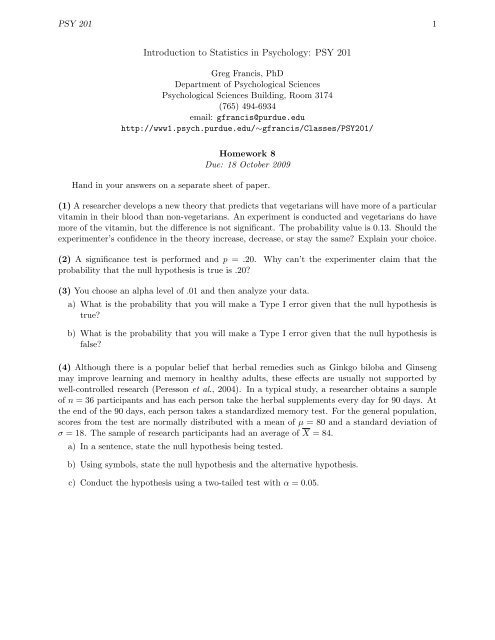
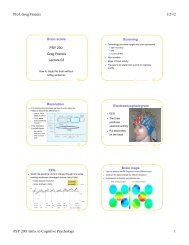

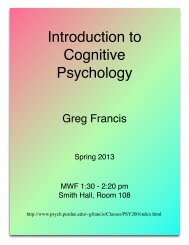
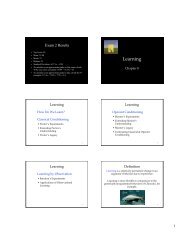
![Exam 4 Study Guide[1]](https://img.yumpu.com/45196739/1/190x245/exam-4-study-guide1.jpg?quality=85)
